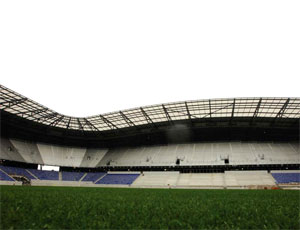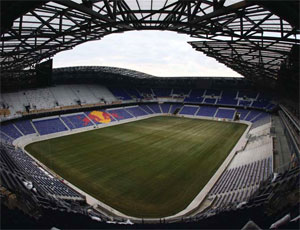Since their inception in 1996, the New York Red Bulls soccer club has been a team without a real home.
The Major League Soccer franchise has been forced to play at Giants Stadium, a sprawling, cavernous facility built for American football that never gave off that “home field” advantage you look for in a permanent home.


But with construction completed on the nearly $200 million Red Bull Arena in Harrison, N.J., all of has finally changed. In March, the Red Bulls kicked off the 2010 season in brand new digs, playing on Kentucky bluegrass, close to fans.
“Red Bull Arena was designed with the soccer fan in mind,” said Red Bulls spokesman Andrew McGowan.
Owned by Red Bull GmbH, parent company of the New York Red Bulls, the stadium sits on land owned by the Town of Harrison. Hudson County oversaw construction of the parking garage, located at the Harrison PATH station. And officials are banking on the stadium being the centerpiece of a re-development of tiny Harrison, which is said to include a 250-acre, $1.5 billion revitalization project along Harrison’s waterfront, which promises a mixed-use development that will combine retail and retail space.
Distinctive Design “The design is in the spirit of a European soccer venue,” says Rob Barbera, senior vice president of Hunter Roberts in New Jersey, the project’s general contractor. “The stadium is built around the soccer field, with the event seating close to the field, and every seat is covered from the elements.”
Renowned sports facility architects Rossetti of Southfield, Mich., designed the 380,000-sq-ft, horseshoe-shaped, soccer-specific stadium, which sits on a 12.5-acre site near the Passaic River. Three sides of the building and a lower bowl on the fourth side contain approximately 25,000 seats. The west-facing, long side of the building features 30 luxury suites, a 100-seat press box and support space.
“[The stadium has] a very distinct look,” says Jan Szupinski, lead designer with Rossetti. “The building is compact and was part of a desire to create an intimate and close space to enhance the game experience. Vistas are limited and focused on action on the field.”
Hunter Roberts mobilized in December 2007 and began pile driving in January 2008, before final design documents were completed.
More than 3,000, 40-ft to 50-ft long timber piles, driven to a hard till, support the stadium.
“For the loads that had to be supported, the soils were too soft,” says Glenn Kustera, an associate principal with the structural engineering firm Paulus, Sokolowski and Sartor (PS&S) of Warren, N.J., about the choice of using timber pines. Without them, “there would have been too much settlement.”
The front row sits within 21 feet of the touchlines. All seats enjoy good sightlines. Diagonal steel beams support the precast concrete structure onto which the lower-bowl seats are mounted.
“The upper bowl is aluminum, which is supported by a galvanized secondary steel structural system,” Waldron says. “It is supported by rakers, which run off of the primary structural-steel truss system.”
A structural-steel frame, with trusses spaced 32-ft apart, and additional steel hold a Teflon-coated fabric that forms a roof, cantilevering out 120 feet over the seating bowl. Barbera considered that the most challenging aspect of construction and says it required “an abundance of coordination.”
“Erecting that structure was tricky,” adds Bob Waldron, project executive with Hunter Roberts. “Forty-two trusses start at the ground and make their way up, then curve over the seating area.”
The design team minimized the weight of the roof, so the steel structure could be less substantial yet still withstand necessary wind loads.
“The shape of the stadium is why the steel was so important to the project,” Kustera says. “We had to figure...


Post a comment to this article
Report Abusive Comment